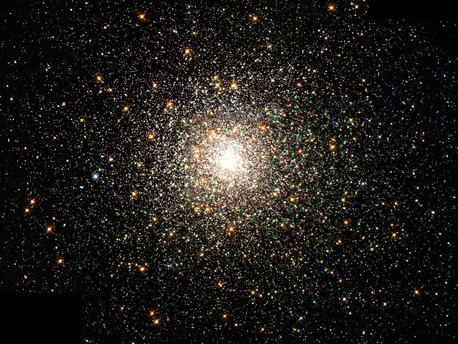Many Dwarfs Surround Us
Alien Invaders Pack The Milky Way
 © NASA/HHT/STScI/AURA
|
A Hubble Space Telescope image of the typical globular cluster Messier 80, an object made up of hundreds of thousands of stars and located in the direction of the constellation of Scorpius. The Milky Way galaxy has an estimated 160 globular clusters of which one quarter are thought to be ‘alien’.
Using Hubble Space Telescope data, Forbes, along with his Canadian colleague Professor Terry Bridges, examined globular star clusters within the Milky Way galaxy.They then compiled the largest ever high-quality database to record the age and chemical properties of each of these clusters. “Using this database we were able to identify key signatures in many of the globular star clusters that gave us tell-tale clues as to their external origin,” Forbes said.
“We determined that these foreign-born globular star clusters actually make up about one quarter of our Milky Way globular star cluster system. That implies tens of millions of accreted stars – those that have joined and grown our galaxy – from globular star clusters alone.”
The researchers’ work also suggests that the Milky Way may have swallowed up more dwarf galaxies than was previously thought. “We found that many of the foreign clusters originally existed within dwarf galaxies - that is ‘mini’ galaxies of up to 100 million stars that sit within our larger Milky Way.
“Our work shows that there are more of these accreted dwarf galaxies in our Milky Way than was thought. Astronomers had been able to confirm the existence of two accreted dwarf galaxies in our Milky Way – but our research suggests that there might be as many as six yet to be discovered.
"Although the dwarf galaxies are broken-up and their stars assimilated into the Milky Way, the globular star clusters of the dwarf galaxy remain intact and survive the accretion process. This will have to be explored further, but it is a very exciting prospect that will help us to better understand the history of our own galaxy.”
Source: The Royal Astronomical Society
Many Dwarfs Surround Us
Alien Invaders Pack The Milky Way
 © NASA/HHT/STScI/AURA
|
A Hubble Space Telescope image of the typical globular cluster Messier 80, an object made up of hundreds of thousands of stars and located in the direction of the constellation of Scorpius. The Milky Way galaxy has an estimated 160 globular clusters of which one quarter are thought to be ‘alien’.
Using Hubble Space Telescope data, Forbes, along with his Canadian colleague Professor Terry Bridges, examined globular star clusters within the Milky Way galaxy.They then compiled the largest ever high-quality database to record the age and chemical properties of each of these clusters. “Using this database we were able to identify key signatures in many of the globular star clusters that gave us tell-tale clues as to their external origin,” Forbes said.
“We determined that these foreign-born globular star clusters actually make up about one quarter of our Milky Way globular star cluster system. That implies tens of millions of accreted stars – those that have joined and grown our galaxy – from globular star clusters alone.”
The researchers’ work also suggests that the Milky Way may have swallowed up more dwarf galaxies than was previously thought. “We found that many of the foreign clusters originally existed within dwarf galaxies - that is ‘mini’ galaxies of up to 100 million stars that sit within our larger Milky Way.
“Our work shows that there are more of these accreted dwarf galaxies in our Milky Way than was thought. Astronomers had been able to confirm the existence of two accreted dwarf galaxies in our Milky Way – but our research suggests that there might be as many as six yet to be discovered.
"Although the dwarf galaxies are broken-up and their stars assimilated into the Milky Way, the globular star clusters of the dwarf galaxy remain intact and survive the accretion process. This will have to be explored further, but it is a very exciting prospect that will help us to better understand the history of our own galaxy.”
Source: The Royal Astronomical Society






